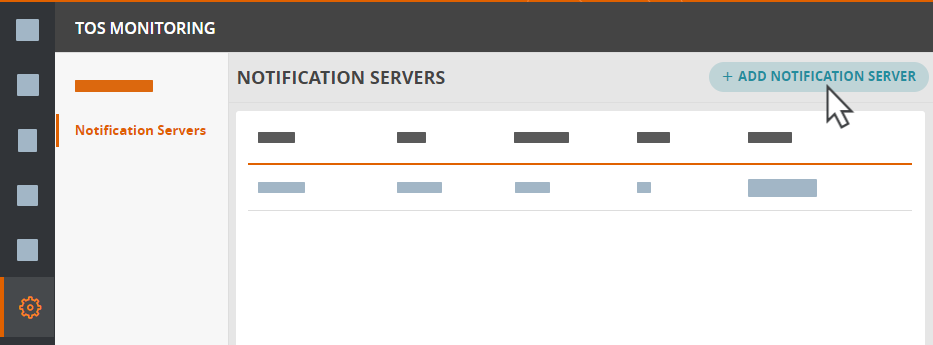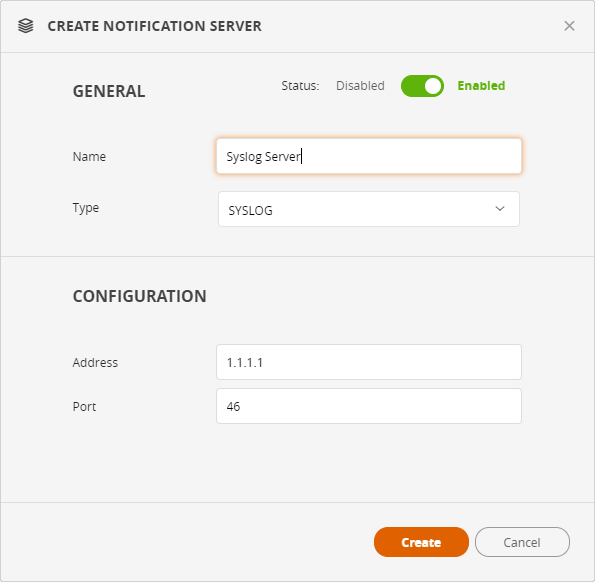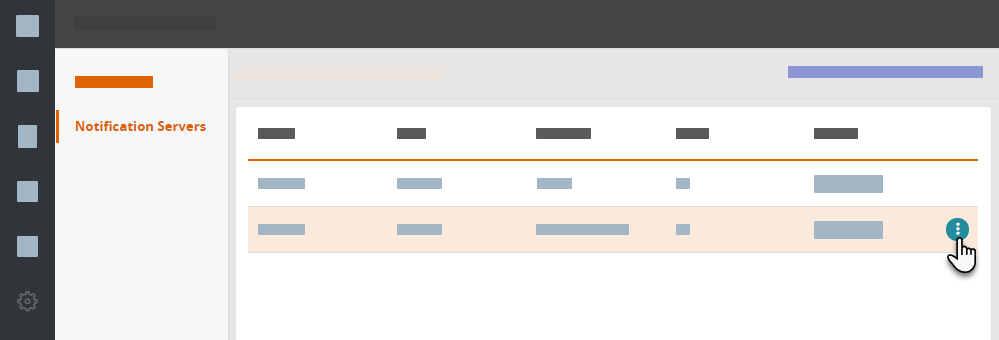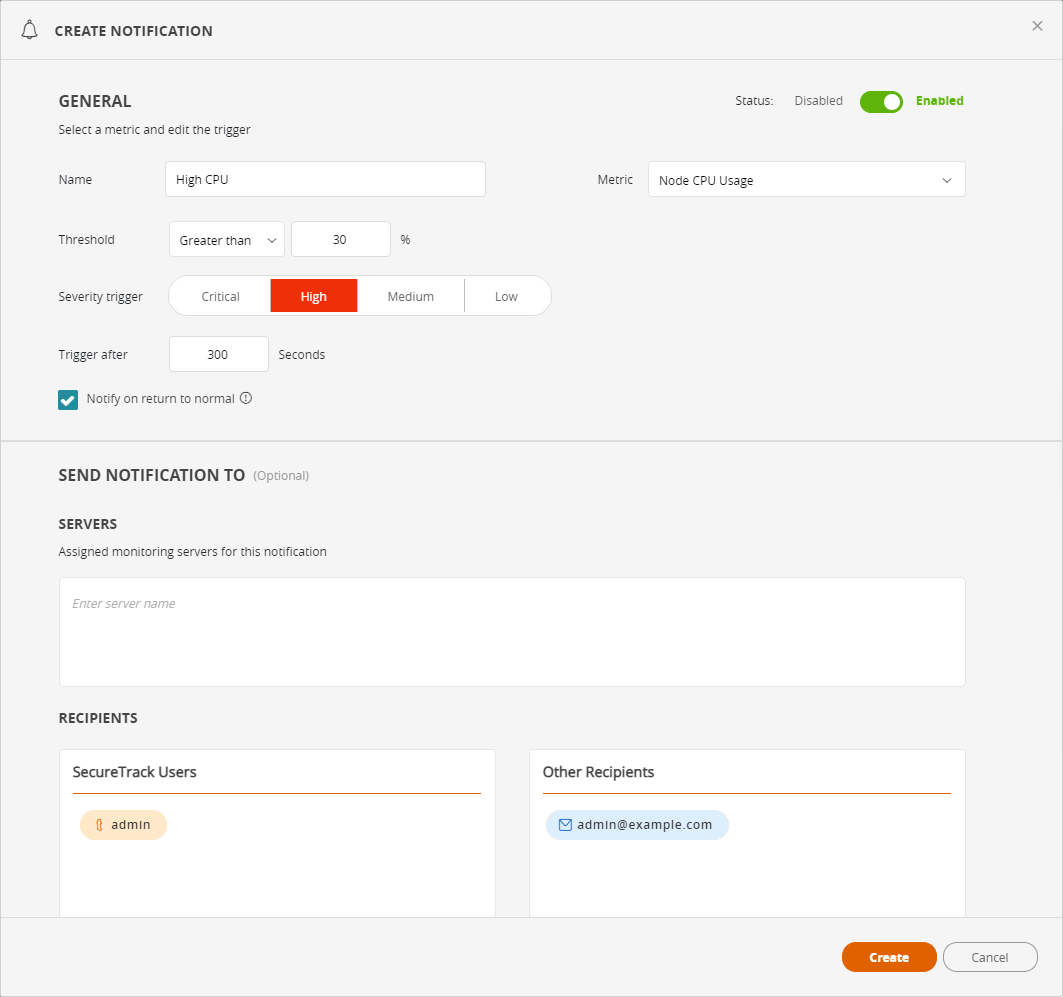On This Page
TOS Monitoring
Overview
TOS Monitoring lets you monitor the status of the TOS cluster and its nodes by generating a notification whenever a change in status occurs, such as a node failing, or a usage threshold reached, such as CPU or disk usage.
A notification is sent when the event first occurs, and again every 24 hours until the issue is resolved. There is an option to receive a notification when the metric goes back below the threshold and the system returns to normal.
Notifications can be sent to selected SecureTrack users, other email address, SIM/SIEM, and/or to one or more notification servers of type syslog, SNMPv2 or SNMPv3 (requires additional configuration).
Notifications are supported for both central and remote clusters.
This feature is only available to Administrators / Super Administrators.
You can also monitor TOS Aurora using third-party tools with the help of the TOS Aurora MIB file - see Using SNMP get/walk in TOS Cluster Monitoring.
Default Notifications
There are two default notifications:
-
DB Status Alert: Monitors database status and sends an alert to the recipients configured in the notification when a database goes offline.
-
Partition usage alert: Monitors the available storage in the /opt directory. When the directory becomes more than 80% full an alert is sent out to the recipients configured in the notification.
After an upgrade, the default alerts will be sent to all existing TOS administrator users.
Syslog Output Format
Example:
Facility user (1), Severity alert (1)
Msg: May 22 16:31:21 monitor-tower-service-649778dc6b-jw2zp -: TOS Monitoring Notification\0x0a\0x0a-----------------------\0x0a\0x0aNotification Name: te\0x0aNotification Metric: Partition Filesystem Usage\0x0aGenerated on: 2024-05-22T13:31:21.158Z\0x0aTime of Occurrence: 2024-05-22T13:31:16.092Z\0x0aCluster Name: Centr\0x0aNode Name: tufin\0x0aPartition Name: /dev/mapper/VolGroup01-LogVol01\0x0aPartition Filesystem Usage: 3\0x0aNotification Status: firing\0x0aNotification Threshold: 1\0x0aNotification Severity: critical\0x0aNotification Description: \0x0a
Limitations
-
Due to a technical limitation, notifications for malfunctioning of one particular database - MongoDB - will not be sent until the database is back running correctly.
What Can I Do Here?
Add a Notification Server
-
Select Notification Servers > Add Notification Server.
-
Enter the following information:
-
Name: The name for the server that will be displayed on the Notifications Window.
-
Type: Select the server type - Syslog, SNMPv2, or SNMPv3.
SNMP servers will need the TOS Aurora MIB file in the appropriate location (on Linux servers, typically /usr/local/share/snmp/mibs or /usr/share/snmp/mibs). This file supports SNMPv2 and SNMPv3.
If you select SNMPv3, you must also configure the SNMPv3 parameters.
-
Address: The IP Address or FQDN of the server.
-
Port: The server port (UDP only)
-
Community: The community, this option is only available for SNMP.
-
- Click Create.
Once you have added the server, you can modify, delete, or disable the server using the ![]() button next to the name of the server.
button next to the name of the server.
Add a Notification
-
Select Notifications > Add Notification.
-
Enter the following information:
-
Name: The name for the notification that will be displayed on the Notifications Window.
-
Metric: The metric that will be monitored, select one of the following:
-
Node CPU Usage
-
Node Memory Usage
-
Partition Filesystem Usage (disk usage)
- Database Status
- Deployment Status (node failure, HA status etc.)
If you want to change the metric after you have created the notification, you must delete and create a new one.
-
-
Threshold: Whether the threshold should be a minimum or maximum value and the threshold percent value.
-
Severity trigger: Whether this notification should be designated as Critical, High, Medium, or Low.
-
Trigger after: The number of seconds to wait before a notification is sent. This is useful to prevent unnecessary triggers, for example if a regular process uses a lot of memory for a few seconds, you would not want a trigger to be generated every time the process runs. The trigger must be between 180 and 3600 seconds. the default is 300 seconds (5 minutes).
-
Notify on return to normal: Select this option to have a second notification sent when the metric goes back below the threshold level, or a failure status has been rectified.
-
-
If you want to send the notification to one or more notification servers, click on the Notification Servers area and start typing the server name, then select from the list to add. Repeat if desired for additional servers.
-
If you want to send the notification to one or more users by email:
-
User Admin is added by default to SecureTrack Users. Delete if not required.
-
To send the notification to a SecureTrack user, start typing the user name in the SecureTrack Users area and select as needed. Repeat as necessary.
-
To send the notification to other email addresses, click on the Other Recipients area and enter the required email address. Repeat as necessary.
To send reports via email, the SMTP mail server needs to be configured, see Configuring Servers (SMTP and Syslog).
-
-
Click Create.
Once you have created the notification, you can modify, delete, or disable the notification using the ![]() button next to the name of the notification.
button next to the name of the notification.
How Do I Get Here?
In SecureTrack, go to Admin ![]() > TOS Monitoring.
> TOS Monitoring.





